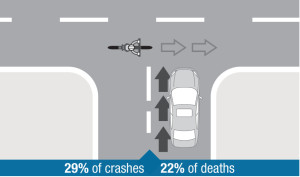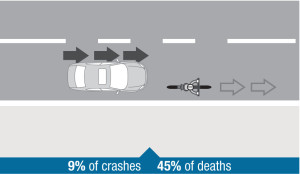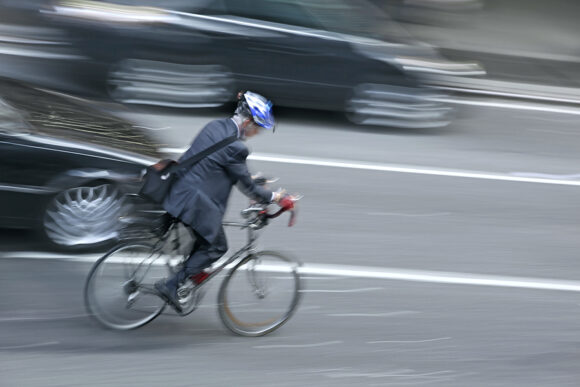New research suggests a notable decline in bicyclist deaths in the last several decades, however, according to a Centers for Disease Control and Prevention report on bike auto collision-related deaths between 1975 and 2012, “though bicycles account for only about 1 percent of trips across all modes of transportation, on a per trip basis, bicyclists die on U.S. roads at a rate double that of vehicle occupants”.
The CDC research found that bicyclist deaths declined by 44 percent during the studied period. The biggest reduction was among children aged 15 and younger. Fatality rates for adults aged 35 to 74 years increased since 1975.
During the 38-year study period, there were 29,711 bicyclist fatalities recorded. Annually, the report found that “bicyclist fatalities declined from a high of 955 in 1975 to 717 in 2012.
Deaths among males was six times greater than for females, according to the report, “In 2012, males accounted for 87 percent of total bicycle deaths in the United States. This proportion increased over the 38-year study period, from 79 percent in 1977 to a peak of 90 percent in 2001.”
All 48 states and the District of Columbia experienced a decrease in age-adjusted cyclist mortality rates when comparing averages during the first five years with those during the last five years of the study period. Maine saw the greatest decline in cyclist deaths (78.7 percent), while Florida reported the lowest decreases (9.7 percent) in its age-adjusted cyclist mortality rate.
While biking among youths declined the most, during 2000–2012, the number of U.S. workers who traveled to work by bicycle increased 61 percent. According to the CDC, many countries as well as some U.S. cities have recorded higher bicycle use and lower mortality rates than the United States overall. Some reasons for this may include an emphasis on the benefits of cycling while proactively addressing bicycle safety. Some examples of safety improvements include physically separating bike lanes, speed bumps to slow the speed of motorized vehicles and lower speed limits. The CDC noted that other strategies that could improve bicycle safety included mandatory helmet laws and improved conspicuity of cyclists through the use of lights and by wearing reflective clothing
The National Highway Traffic Safety Agency did their own research and found that in 2013, 743 bicyclists died and 48,000 were injured in crashes with cars. An interesting aspect of the NHTSA’s research is that one fourth of those killed in 2013 had blood alcohol content greater than 01.
Fatalities were highest in California, Florida and Texas. Five states – Vermont, Wyoming, South Dakota, Nebraska and West Virginia – reported no bicycle fatalities in 2013.
A newly released study by the Journal of the American Medical Association noted an increase in bicycle-related injuries and hospital admissions between 1998-2013. And as more workers were noted to be traveling to work by bicycle, JAMA found that injuries among those 45 and older increased substantially (by 81 percent) along with the frequency of hospital admissions (from 39 to 65 percent). In addition, the percentage of cyclists that sustained head injuries increased from 10 to 16 percent.
The JAMA study’s authors indicate that “possible factors contributing to the increase in overall injuries and hospital admissions include an increase in street accidents and an increase in sport cycling associated with faster speeds.“
The JAMA authors also noted that “As the population of cyclists in the United States shifts to an older demographic, further investments in infrastructure and promotion of safe riding practices are needed to protect bicyclists from injury.”
Technology Already in Use
Safety campaigns and changes to road infrastructure aren’t the only ways to address bike auto collisions, according to the Insurance Institute for Highway Safety, which conducted their own study and found that the findings could aid in the development of bicyclist detection systems for cars.
According to IIHS’ research, between 2008 and 2012, 74 percent of the 3300 bicyclists that died were involved in a crash where a bicycle was hit by the front of a car.


Of those, the most common scenario at 45 percent, the IIHS noted, was of a vehicle traveling in the same direction as the bicycle and hitting it from behind. Following at a close second – 22 percent, was a bicycle crossing a vehicle’s path. Though this type of scenario is harder to detect, automakers have already developed pedestrian detection systems that identify when a person has stepped into the roadway and could be used to develop a similar bicycle detection system, the IIHS stated.
According to the safety agency, while bicycle crashes represent a small number of deaths on U.S. roads overall, they have been increasing since 2010.
The IIHS noted that a number of crashes could potentially be addressed. “Systems designed with the three most common deadly crash scenarios in mind have the potential to help mitigate or prevent up to 26 percent of bicycle crashes and 52 percent of fatal crashes. Systems that also address the remaining two most common crash modes could help mitigate or prevent up to a total of 47 percent of crashes and 54 percent of fatal crashes.”
Automakers have already designed crash prevention technology that can identify the back of a vehicle to prevent a rear end crash. The IIHS speculates that automakers need only make these systems better able to identify the backs of bicyclists and bicycles, “adding the capability to identify bicyclists to these systems could prevent or mitigate up to 32 percent of fatal bike crashes and up to 6 percent of all bike crashes.”
The IIHS study also examined the time of day and vehicle speeds at which the fatal crashes occurred. “Half of fatal crashes and nearly a quarter of all crashes involving the front of a vehicle occurred at night or during twilight. Most crashes occurred on roads with speed limits of less than 40 mph, but only about a third of fatal ones did. Currently, not all front crash prevention systems are effective in darkness or at high speeds, but they would need to be to have the biggest effect on bicyclist crashes and fatalities,” the study’s authors stated
“Biking has been enjoying a resurgence in recent years, as individuals and local governments seek a greener form of transportation that doesn’t contribute to traffic congestion,” says David Zuby, IIHS executive vice president and chief research officer. “The auto industry should keep bicyclists in mind as it continues to develop crash avoidance technology.”
Was this article valuable?
Here are more articles you may enjoy.


 Report: Insurers Pay $1.6B in Dog Bite Claims, as Frequency Soars
Report: Insurers Pay $1.6B in Dog Bite Claims, as Frequency Soars  La Niña’s End Threatens to Unleash an Active Atlantic Hurricane Season
La Niña’s End Threatens to Unleash an Active Atlantic Hurricane Season  Audi Q6, Three Other Vehicles Earn IIHS 2025 Safety Awards
Audi Q6, Three Other Vehicles Earn IIHS 2025 Safety Awards  FBI Says Cybercrime Costs Rose to at Least $16 Billion in 2024
FBI Says Cybercrime Costs Rose to at Least $16 Billion in 2024 